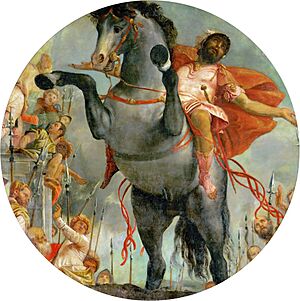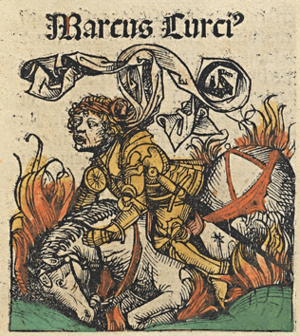Marcus Curtius facts for kids

Marcus Curtius is a legendary young Roman hero. He is famous for a brave act where he offered himself to the gods to save Rome. His story is told by ancient Roman writers like Livy. The Lacus Curtius in the Roman Forum is named after him. It is said to be the exact spot where his amazing sacrifice happened.
Contents
Marcus Curtius: A Roman Hero
The Mysterious Pit in Rome
In 362 BC, a huge and very deep hole suddenly opened up in the middle of the Roman Forum. The Roman Forum was the main marketplace and meeting place in ancient Rome. The Romans tried everything to fill this giant pit, but nothing worked. They became very worried about it.
To find out what to do, they asked a special priest called an augur. The augur told them that the gods wanted Rome's most precious possession. The Romans were confused. They wondered what this "most precious possession" could be.
A Brave Sacrifice for Rome
Then, a young soldier named Marcus Curtius stepped forward. He told everyone that Rome's most precious things were its brave soldiers and their courage. He believed that the strength and spirit of the Roman people were what truly mattered.
Marcus Curtius then got on his horse. He was fully dressed in his armor and looked very grand. With everyone watching, he bravely rode his horse and leaped straight into the deep pit. As soon as he jumped, the ground closed up over him. This amazing act saved Rome from the danger the pit represented.
The place where this happened in the Forum was later named the Lacus Curtius. It is a famous spot that reminds everyone of Marcus Curtius's incredible bravery.
Marcus Curtius in Art
The story of Marcus Curtius became very popular, especially during the Renaissance. This was a time in history when people rediscovered old stories and art. Artists loved the idea of someone sacrificing themselves for their community.
Many famous artists created pictures and etchings of Marcus Curtius. These included German artist Lucas Cranach the Elder and Dutch artist Hendrick Goltzius. The story was also shown in the famous Nuremberg Chronicle, a book from 1493. These artworks helped keep Marcus Curtius's heroic tale alive for centuries.


